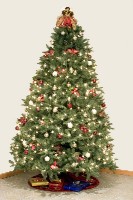Fir Trees: A Christmas Favorite
Holidays Trivia, Nature Trivia Bringing home and decorating the Christmas tree is one of the most exciting events of the year for families around America. It marks the beginning of the holiday season and a time of cheer for many people. Families decorate the tree with lights and ornaments so they can watch it glitter and shine throughout December. A tree commonly used as a Christmas tree is the fir tree. It’s beautiful, full needles and limbs are easy to decorate and add the look and feel of the season to any home. Below is a brief look at how the fir tree came to be a part of Christmas, and a description of the different types of fir trees in America.
Bringing home and decorating the Christmas tree is one of the most exciting events of the year for families around America. It marks the beginning of the holiday season and a time of cheer for many people. Families decorate the tree with lights and ornaments so they can watch it glitter and shine throughout December. A tree commonly used as a Christmas tree is the fir tree. It’s beautiful, full needles and limbs are easy to decorate and add the look and feel of the season to any home. Below is a brief look at how the fir tree came to be a part of Christmas, and a description of the different types of fir trees in America.
Fir Trees in Christmas History
Fir trees have been used as Christmas trees for centuries. The earliest record of this was in the 7th century, when a monk allegedly used a fir tree to describe God’s Holy Trinity to the people he was teaching. The converted people, who once reverenced the oak tree as “God’s Tree,” began using the fir tree instead. During the 12th century, people were hanging fir trees upside down from their ceilings as a symbol of Christianity.
In 1510, Martin Luther, the well-known Christian reformist, is said to have decorated a tree with candles, to offer his children a glimpse of starlight in the night. German towns began to develop Christmas markets during the 16th century, and also the first tinsel was invented in Germany. The Christmas markets offered food, gifts, ornaments and souvenirs.
Traditions of the fir Christmas tree spread from Germany to England, and during the 1800s, the Christmas tree was introduced to England by Kings who came from Germany. However, it wasn’t until Queen Victoria and Prince Albert (a German Prince), were shown standing around a Christmas tree with their children in the London News that the English population began to adopt the tree as a custom. Because of Queen Victoria’s prominence and popularity among the people, they immediately followed her example and excepted the tree as a new fashion!
Christmas Trees in America
Christmas trees were introduced to America by early settlers from several different origins and customs, including German Hessian soldiers, Cattle Barons and the East Coast Society. Americans enjoy a variety of fir trees, and decorations vary from house to house. In recent years, Americans have developed a variety of Christmas themes and colors for decorating their tree, making each tree decor unique.
Types of Fir Trees Grown in the United States
1) Balsam Fir – This fir is named after balsam found in blisters on bark. It has short needles with a deep green color. Balsam Firs are typically found in the Northeast United States.
2) Fraser Fir – A tree named after botanist John Fraser, explorer of the Appalachians during the 1700s. It has beautiful dark green needles and a lovely scent. Its branches are turned upward. Fraser Firs grow in the Alleghenies.
3) Douglas Fir – Named after David Douglas, who studied the Douglas Fir in the 1800s, this tree is blue to dark green in color and has a very good aroma. It can live up to a thousand years!
4) Grand Fir – This tree has dark green needles that shine. Its needles smell like citrus when crushed.
5) White Fir – Also known as the Concolor Fir, this tree has bluish-green needles and gives a citrus scent. White Firs grow in the Northwest United States on lower mountain slopes.
6) Nordmann Fir – A tree that’s widely used in the United Kingdom. It has flat, dark green needles.
7) Noble Fir – A tree commonly used to make wreaths and garland, the Noble Fir has bluish-green needles and offers a silvery appearance. Noble Firs typically grow at high altitudes.
Alternatives to Fir Trees
Although fir trees still play a major part in Christmas, many other types of trees have been used throughout history to reduce damage to fir trees. Artificial trees are popular because they’re cost-efficient for the long term and require no care. Through tradition and culture, the Christmas tree has managed to survive for centuries, and is still used in millions of homes today!
